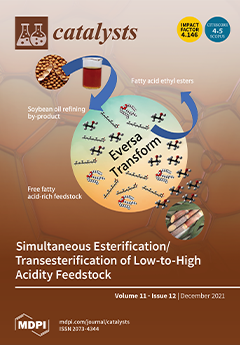In this work, the optimization of Ni amount on LaFeO
3 photocatalyst was studied in the photocatalytic molecular hydrogen production from glucose aqueous solution under UV light irradiation. LaFeO
3 was synthesized via solution combustion synthesis and different amount of Ni were dispersed
[...] Read more.
In this work, the optimization of Ni amount on LaFeO
3 photocatalyst was studied in the photocatalytic molecular hydrogen production from glucose aqueous solution under UV light irradiation. LaFeO
3 was synthesized via solution combustion synthesis and different amount of Ni were dispersed on LaFeO
3 surface through deposition method in aqueous solution and using NaBH
4 as reducing agent. The prepared samples were characterized with different techniques: Raman spectroscopy, UltraViolet-Visible Diffuse Reflectance Spettroscopy (UV–Vis-DRS), X-ray Diffraction (XRD), X-ray Photoelectron Spectroscopy (XPS), X-ray Fluorescence (XRF), Transmission Electron microscopy (TEM), and Scanning Electron microscopy (SEM) analyses. For all the investigated photocatalysts, the presence of Ni on perovskite surface resulted in a better activity compared to pure LaFeO
3. In particular, it is possible to identify an optimal amount of Ni for which it is possible to obtain the best hydrogen production. Specifically, the results showed that the optimal Ni amount was equal to nominal 0.12 wt% (0.12Ni/LaFeO
3), for which the photocatalytic H
2 production was equal to 2574 μmol/L after 4 h of UV irradiation. The influence of different of photocatalyst dosage and initial glucose concentration was also evaluated. The results of the optimization of operating parameters indicated that the highest molecular hydrogen production was achieved on 0.12Ni/LaFeO
3 sample with 1.5 g/L of catalyst dosage and 1000 ppm initial glucose concentration. To determine the reactive species that play the most significant role in the photocatalytic hydrogen production, photocatalytic tests in the presence of different radical scavengers were performed. The results showed that •OH radical plays a significant role in the photocatalytic conversion of glucose in H
2. Moreover, photocatalytic tests carried out with D
2O instead of H
2O evidenced the role of water molecules in the photocatalytic production of molecular hydrogen in glucose aqueous solution.
Full article





